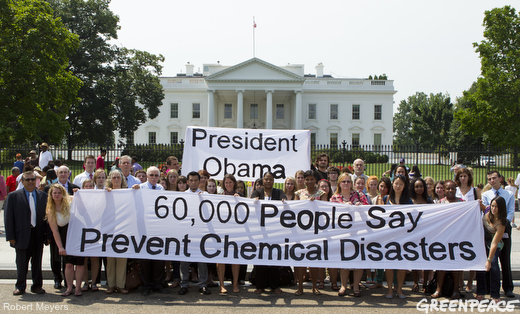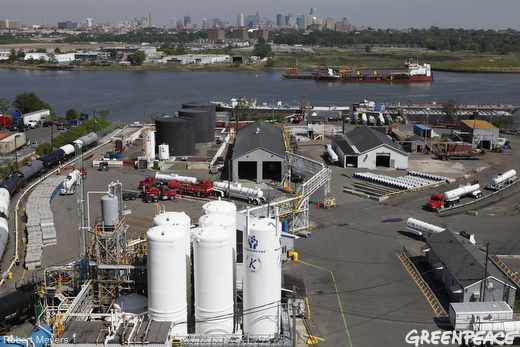NAMA's Science Coordinator
A few weeks
ago I represented NAMA and joined a group of individuals and organizations who
are part of a coalition for chemical safety at a meeting with White
House staff (primarily from the office of the Council on Environmental
Quality or CEQ) to promote the need for safer alternatives to
toxic chemicals. We delivered an electronic petition with 60,000
signatures supporting safer chemical alternatives, and a copy of a
petition signed by 100+ organizations (including NAMA) asking EPA to
“exercise its authority under…the clean air act to prevent chemical
facility disasters through the use of safer chemical processes.”
Greenpeace
was the lead on the petitions and organization of this meeting.
Representatives of a number of community organizations, labor unions, and
health facilities were present to offer the perspectives of vulnerable workers,
neighborhoods and first responders (EMTs, ER doctors and nurses, and field
nurses).
 |
|
The
environmental message was human health and safety for communities, but the main
purpose of this meeting was to stress the national
security relevance, which legally trumps all others. I was the only
voice for fishermen and fishing communities, and it was a way of demonstrating
our support for all efforts to slow and stop the flow of toxic substances into
the marine environment that nurtures wild fish populations. Furthermore, many
fishing communities have chemical plants or storage facilities, and are close
to ports and rail yards that may be the port of call for dangerous chemical
cargo and may offer storage for such cargo. My participation served as an
introduction to the importance of this issue to fishing communities. The
organizer had this take on the threat to fishermen: big chemical businesses
hurting small fishing businesses. How, for instance, would the presidential
candidates protect those small businesses from being damaged or wiped
out, by a toxic chemical accident caused by big industry?
 |
| OIL STORAGE TANKS DAMAGED BY KATRINA David Helvarg, Blue Frontier Campaign |
I learned a
lot from these community representatives who have been working on this issue
for some time. Some are focused on environmental justice in poor
communities with citizens and plant workers vulnerable to frequent
accidents (the average person outside these plants would be shocked, as I
was, to find out how frequently fires and small accidents may occur –
statistics are given in numbers of occurrences per week!). Others working
in health care institutions expected to take care of victims of chemical
accidents made it clear they could never adequately respond to a major
accident.
Storage tanks
at factories, water treatment plants, and ports and rail cars pose
threats of leaks, spills, and explosions. If they’re close to the shore or
even to fresh water flowing into the ocean, they threaten fisheries, fishing
boats, and fishing communities. And most of the port located chemical
facilities are exempt from the federal chemical security rules and only deal
with Coast Guard rules relating to their port entrance and perimeter rather
than hazardous chemicals on site.
The
vulnerability of fishermen to toxic accidents has been clearly illustrated in
living color TV images from the BP blow-out in the Gulf of Mexico. Fishermen
and fishing communities are vulnerable to volatile toxins and fish are
vulnerable to toxins in the water. Coastal communities with ports and railroads
are vulnerable when toxic chemicals are transported in and out or are
stored, sometimes in very large volumes. And like any community, coastal
communities with industrial facilities and water treatment plants that use
volatile toxic chemicals are susceptible to accidental releases and
serious accidents.
 |
There are
some ironies in these scenarios:
1)
Responsible fishermen are intensely attentive to safety details when it comes
to their boats going out to sea, yet here they are
needlessly threatened by careless policies that make them vulnerable to
toxic releases and accidents.
2) Not
only are fishermen in harm's way, but so are the fish stocks that the
government, fisheries managers, and fishermen are trying
so diligently to rebuild.
What good is a rebuilding program tainted by toxic substances in the waters
where young fish are trying to survive? It’s time that sources of toxic
pollution are considered and addressed in fisheries management and stock
rebuilding plans.
3) Many
of the goals
of the National Ocean Policy, which is being championed by CEQ, are
jeopardized by the existence of significant volumes of toxic
chemicals being transported, stored and sometimes manufactured in ports
and other waterfront areas and transported by sea.
We know that
our friends who are fishermen or live in fishing communities in the Gulf of
Mexico region are severely threatened by toxic chemical leaks and accidents at
multitudes of chemical production and storage sites (see Greenpeace’s map of high risk chemical plants).
We should all keep that in mind when oil and gas exploration and transport is
proposed for our coastal waters. But there are also hot spots along the Atlantic and Pacific coasts.
In the Northwest Atlantic region between the Canadian border and Cape Hatteras,
where NAMA’s work is primarily focused, the Greenpeace map shows less intense
concentration of major dangerous chemical plants, except in New Jersey. In New
England there are few identified, such as GAC Chemical Corporation in
Searsport, ME; JCI Jones Chemicals, Inc. in Merrimack, NH; Univar USA, Inc. and Tanner Industries,
Inc. in Providence. But in this region the port storage facilities may be a
more common threat, and numerous sources of chemical pollution have been
identified in a comprehensive study in the New York Times. If you want to
explore facilities around your area with EPA emissions violations and you have
access to the NY Times, click here
to view Massachusetts or to find your state.
There are a
number of opportunities to join with other organizations fighting toxic
pollution – which invariably ends up in the ocean. This chemical security
coalition is but one approach, but it seems to have direct relevance to coastal
fishing communities and their health.


That's very useful information, especially for fishers out there. :)
ReplyDeleteBy: Mae of Alaska Salmon Fishing
Such a excellent article about fishing, it's very useful information. Today, many chemical industries are built near a sea, river and many water resources. The waste materials of this companies transfer to the near water resources, so these materials are harmful for fishes. We should all keep that in mind when oil and gas exploration and transport is proposed for our coastal waters. big chemical businesses hurting small fishing businesses. How, for instance, would the presidential candidates protect those small businesses from being damaged or wiped out, by a toxic chemical accident caused by big industry? Market Research Companies
ReplyDeleteNice post.
ReplyDeleteThan you for your information.
Water Chemical Solution